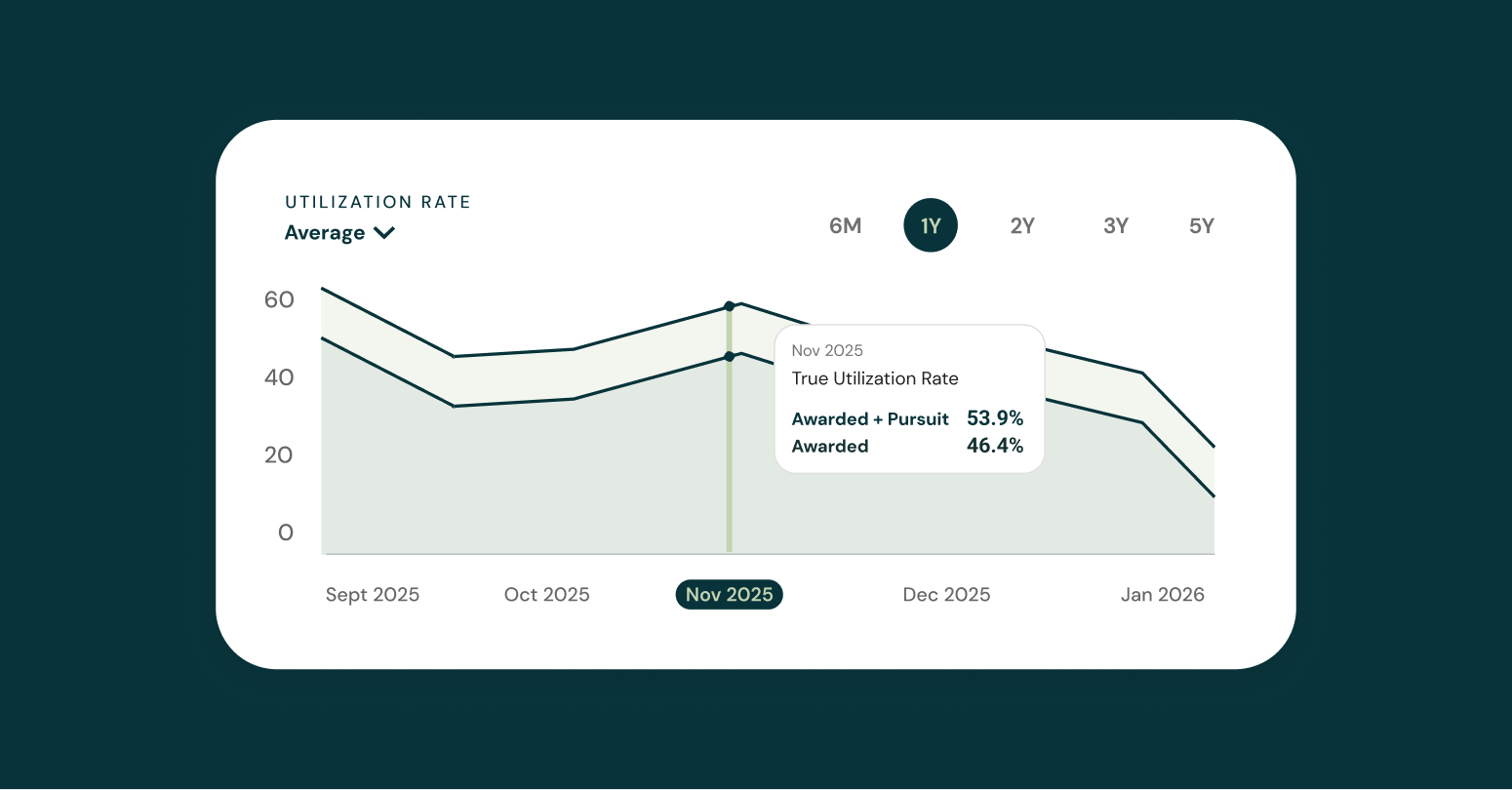You’re at an industry conference, catching up with someone you haven’t seen in years. They’ve just landed three major projects. Good news, right? Except they look exhausted. “We bid these jobs assuming we had the people,” they tell you. “Now we’re scrambling. I have no idea if we can actually deliver.”
Table of Contents
You win work, but you can’t staff it. You make commitments based on assumptions about labor availability that turn out wildly optimistic. By the time you realize the gap between your workforce plan and reality, you’re already behind schedule with clients asking questions you don’t have good answers for.
A construction industry under pressure
You and your conference friend both feel it. The construction industry is transforming in ways that make workforce planning harder, not easier.
Eighty-six percent of contractors have bid on projects only to discover they lack the workforce to complete them. This isn’t a staffing hiccup. It’s a mismatch between what you’re promising and what you can deliver. When you can’t staff the work you’ve already won, your bidding strategy becomes a liability instead of a competitive advantage.
The construction industry needs 439,000 net new workers in the US alone. The pipeline isn’t filling fast enough. Ninety-three percent of construction leaders report that labor shortages directly impact operations. The consequences show up everywhere:
- Increased costs eating into margins
- Inability to take on new work even when the pipeline is strong
- And, employee burnout from overextended teams trying to cover gaps
Turnover rates average 21.4% across the industry. That means one in five people on your crew this year won’t be there next year. You’re constantly recruiting and training just to maintain current capacity, let alone grow. Forty-five percent of contractors report project delays tied directly to workforce issues. These aren’t minor schedule adjustments. They’re client conversations about missed deadlines and liquidated damages.
Labor shortage is only part of what’s making forecasting harder. Tariffs added 25% to steel and aluminum costs, throwing project timelines into chaos. Material delays cascade into workforce needs. You planned for electricians in July, but steel deliveries push that work to September when those electricians are already committed elsewhere.
Weather extends construction timelines by 15-25%, and climate patterns are getting more erratic. The seasonal patterns you’ve relied on for years don’t hold anymore. Immigration policy changes hit 33% of construction firms, tightening labor markets in ways your five-year averages never predicted.
No wonder the industry feels on edge. Ninety-nine percent of construction leaders plan to invest at least $100,000 in workforce planning tools this year. Labor forecasting isn’t optional anymore. It’s how you stay efficient in an environment that punishes guesswork.
The science of construction labor data
You’re already sitting on a treasure trove of data. Take a few minutes and look at your last construction project report. You track metrics on crew size, utilization rates, time-to-complete by trade. Now pull up the next project report. Then the next one. Trends start emerging. Your eyes can see it through the memories each project brings up. This one ran smooth with the electrical crew hitting every milestone. That one was a headache where mechanical kept waiting on materials and timelines slipped week after week.
That’s the foundation. Companies with stable priorities and markets can use historical data to predict future needs, but you need three to five years of workforce data across different project types. Track utilization rates by trade. Document seasonal fluctuations. Calculate average time-to-hire for different positions, because knowing you need three more electricians by August doesn’t help if it takes four months to recruit and onboard them.
Historical data reveals patterns you miss otherwise. That recurring dip in mechanical trades every January when work slows. The electrical spike during summer when commercial HVAC projects ramp up. Which project types consistently run 15% longer than estimated. Which trades have the highest turnover rates and need continuous recruiting pipelines rather than just-in-time hiring.
Tools like Bridgit centralize workforce data for real-time access. The software handles the computational work. You focus on what it means and what to do about it.
But here’s the catch. Even strong data-driven forecasts need adjustment for what your historical patterns never saw coming. Tariff impacts on material availability don’t show up in your three-year averages. Immigration policy shifts create labor supply constraints your models never anticipated. Your time series model predicts seasonal fluctuations beautifully, but it can’t tell you how a sudden 25% tariff on steel cascades through your timelines and reshapes workforce needs in real time.
Data gives you a baseline. From there, you layer in judgment.
The art of reading what workforce data misses
The art of forecasting is what you just know about a project. When you last saw the jobsite supervisor, he was whistling and looked relaxed. That project’s on track. Compare that to the site where the super looked frazzled and the crew was griping about rework. Both projects might show identical utilization numbers on paper, but you know one is headed for trouble and the other will finish early.
Codifying this art into data points is where things get interesting. Start with the workforce itself. You know which crew members prefer certain types of projects, who has specialized expertise that makes them invaluable on complex jobs, and which veterans can mentor newer hires effectively. This experiential knowledge (preferences, experience levels, seniority, specific expertise) matters just as much as utilization rates and availability. Traditional data tells you if someone is available. Experiential data tells you if they’re the right fit for what’s coming.
Scenario planning prepares you for multiple possible futures. Best case assumes strong economic growth and improved labor availability. Base case projects moderate growth with continued labor shortages. Worst case envisions an economic downturn and severe labor constraints. Each scenario should answer: which jobs need more or fewer workers, what new skills emerge, how flexible is talent supply?
The most critical judgment call is assessing which projects will actually convert to work. During pursuit, assign 10-30% probability depending on competition. Shortlisted, bump to 40-60% based on relationship strength. Preferred contractor, 70-85%. Letter of intent, 90-95%. These percentages should reflect your actual win rates, not your optimism. Design-build firms typically aim for bid-hit ratios of 1:3 (33%), while design-bid-build targets 1:3 to 1:5. If your data shows you win 25% of shortlisted opportunities, plan for one win out of four pursuits, not all four.
Combining both approaches for accurate construction labor forecasting
Start with your quantitative baseline: historical data showing what usually happens, time series trends revealing seasonal patterns, regression analysis linking workforce needs to external factors. This is your foundation.
Then layer in qualitative intelligence. Project manager insights about specific client needs and project complexity. Competitive intelligence about who else is pursuing opportunities. Relationship strength with clients. Your actual bid-hit ratios calculated from past results.
Build in real-time adjustment loops so your forecast stays current. Update monthly as projects win or lose and conditions shift. When that major healthcare project slips 90 days due to permitting delays, cascade the impacts through your workforce plan immediately.
Here’s what this looks like:
| Forecasting Layer | What It Provides | Example |
| Data Baseline | Historical patterns, seasonal trends | Q3 model projects 85% utilization based on awarded projects |
| Judgment Overlay | Manager insights, client intelligence | Two pursuits have difficult owners (lower probability); one is sole-source with strong relationship (raise probability) |
| External Adjustments | Market conditions, policy impacts | Tariff delays push mechanical from Q2 to Q3; wet spring delays outdoor work |
| Real-Time Updates | Current pipeline status, actual win rates | Adjusted forecast: 78% utilization, need three electricians by August |
Bridgit handles this by tracking both traditional metrics (utilization rates, time-to-hire, availability) and experiential factors like crew preferences, specialized expertise, and relationship dynamics. You get a complete picture that purely quantitative or purely qualitative approaches miss. The software accelerates the analysis and spots patterns across projects faster than manual review.
Cross-functional integration makes hybrid forecasting work. Business development provides pipeline intelligence. Project management delivers execution reality about timeline slippage and crew performance. HR contributes recruitment reality about time-to-hire and candidate availability. Finance ensures budget constraints align with staffing plans.
What this means for your workforce forecasting
That stress you felt in the conference room, watching your colleague describe the gap between projects won and people available? You don’t have to live there.
The hardest part is honest probability assessment. Most contractors overestimate their chances of winning projects by 15-20 percentage points. When you assume 60% win probability but actually win 35%, you systematically overstaff and burn cash on premature hiring.
Track actual results. If your “strong relationship” projects win at 55% instead of the 70% you assumed, adjust your model. Calibrate gut instinct against measurable outcomes.
Buffer for volatility. In stable times, 10% contingency covered uncertainties. In 2025, build 20-25% buffers for tariff delays, weather impacts, and labor scarcity.
Update forecasts monthly. When conditions change significantly (major policy shift, unexpected client delay, key competitor movement), update immediately. Build pre-qualified talent pools. Develop strategic subcontractor partnerships. Invest in apprenticeships rather than competing for the same scarce external talent.
Shift to leading indicators. Utilization rates tell you where you’ve been. Pipeline conversion rates spot changes before they materialize. Time-to-hire trends catch recruiting challenges early. These give you months of warning instead of weeks.
Construction companies that master both data analysis and market judgment win more bids at better margins. They thrive by approaching workforce forecasting with the same rigor as financial forecasting. Both predict resource needs. Both blend data with judgment. Both separate winning companies from struggling ones when markets get tough.


